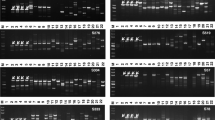Abstract
The genus Trichoderma includes biocontrol agents (BCAs) effective against soilborne plant pathogenic fungi. Several potentially useful strains for biological control are difficult to distinguish from other strains of Trichoderma found in the field. So, there is a need to find ways to monitor these strains when applied to natural pathosystems. We have used random amplified polymorphic DNA (RAPD) markers to estimate genetic variation among sixteen strains of the species T. asperellum, T. atroviride, T. harzianum, T. inhamatum and T. longibrachiatum previously selected as BCAs, and to obtain fingerprinting patterns. Analysis of these polymorphisms revealed four distinct groups, in agreement with previous studies. Some of the RAPD products generated were used to design specific primers. Diagnostic PCR performed using these primers specifically identify the strain T. atroviride 11, showing that DNA markers may be successfully used for identification purposes. This SCAR (sequence-characterised amplified region) marker can clearly distinguish strain 11 from other closely related Trichoderma strains.
Similar content being viewed by others
Author information
Authors and Affiliations
Additional information
Received: 9 June 2000 / Accepted: 5 October 2000
Rights and permissions
About this article
Cite this article
Hermosa, M., Grondona, I., Díaz-Mínguez, J. et al. Development of a strain-specific SCAR marker for the detection of Trichoderma atroviride 11, a biological control agent against soilborne fungal plant pathogens. Curr Genet 38, 343–350 (2001). https://doi.org/10.1007/s002940000173
Issue Date:
DOI: https://doi.org/10.1007/s002940000173




